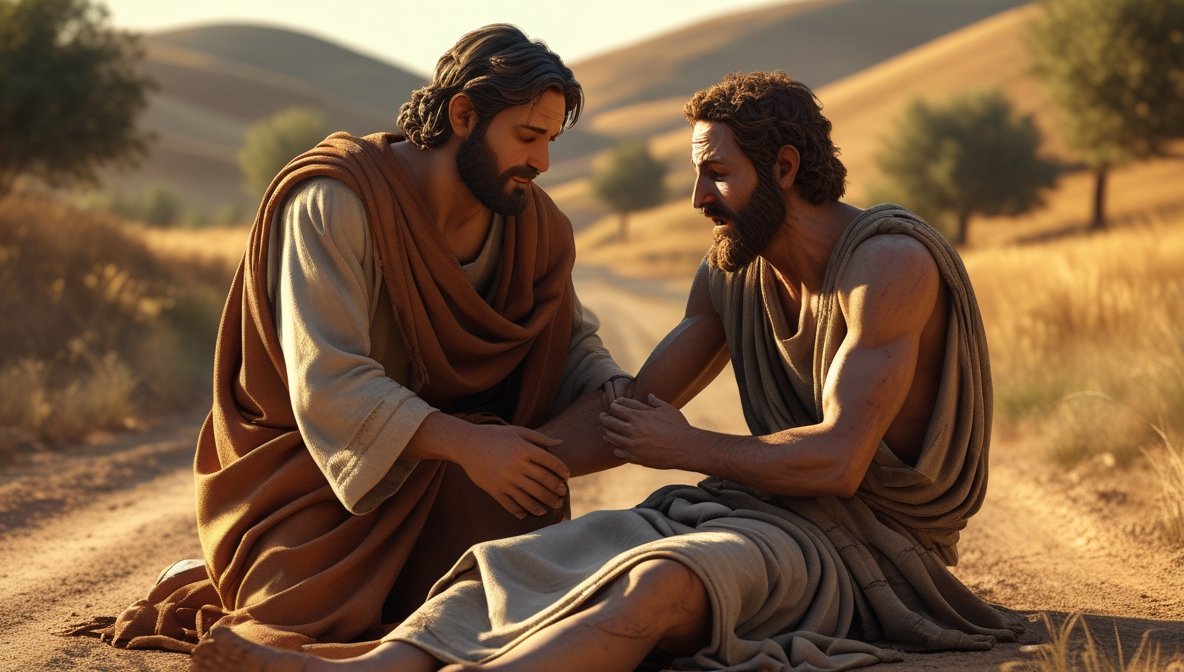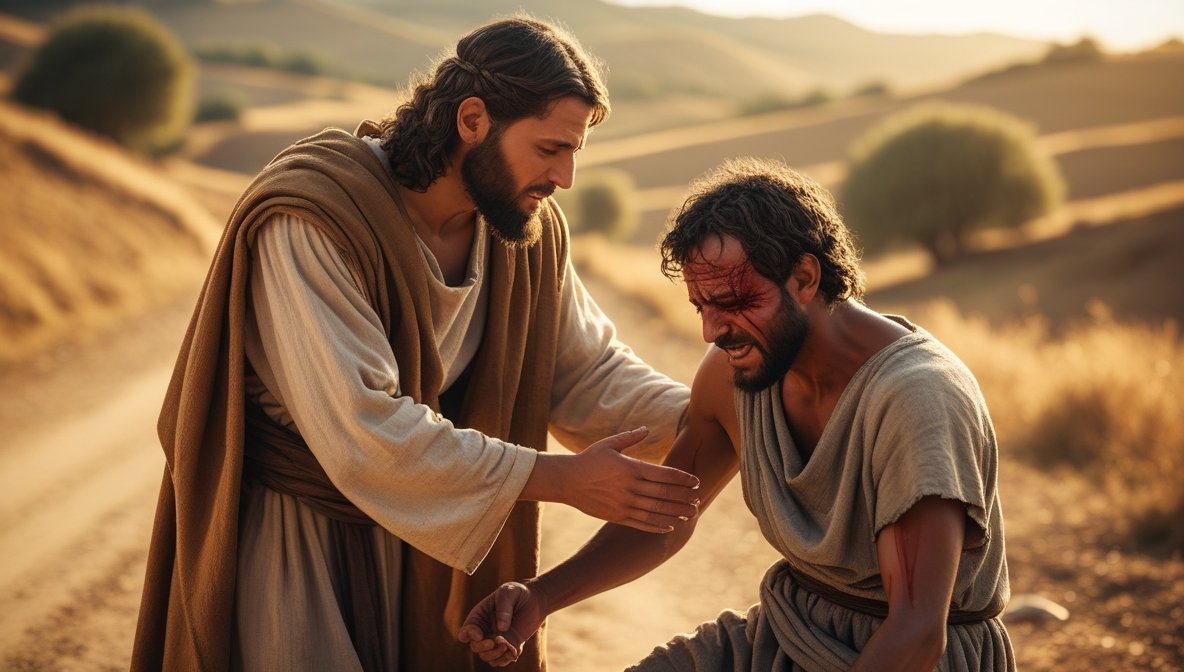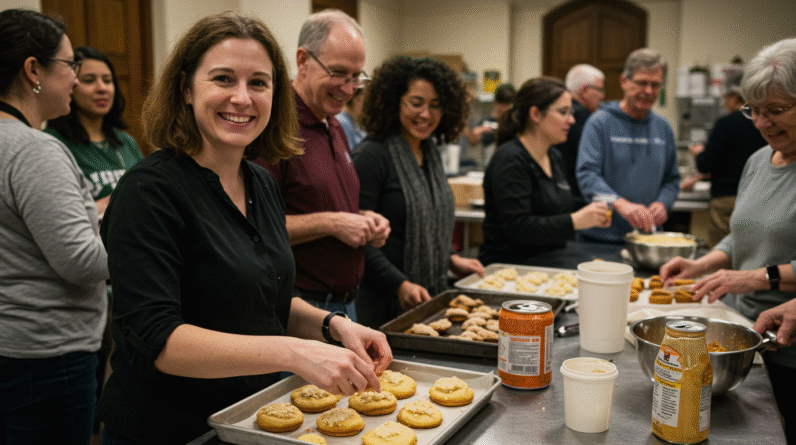The Good Samaritan — Serving Beyond Boundaries
You’re about to unpack one of the most practical and provocative stories Jesus ever told: the parable found in Luke 10:25–37. In this story, Jesus flips expectations, exposes false piety, and shows you what serving with authentic compassion looks like. As you read, you’ll see how the Good Samaritan’s actions redefine service so that it crosses cultural, religious, and personal boundaries. Read the passage here: Luke 10:25–37. This discussion focuses on the Good Samaritan lesson on service and how it calls you out of comfort and into costly compassion.
Why this parable matters to you
The parable is not merely a moral anecdote; it’s a mirror. When Jesus tells the story, He’s answering a question about eternal life, but He’s also naming what it means to live as a neighbor. You will find that the Good Samaritan lesson on service isn’t abstract theology — it’s an operational manifesto for everyday faith. You’ll see how service moves from law to love, from obligation to initiative.
The context: a theological test and a searching heart
When you read Luke 10:25-37, you see a lawyer testing Jesus. He asks, “Teacher, what must I do to inherit eternal life?” (Luke 10:25). The lawyer’s question is sincere but also framed by debate — he wants to narrow salvation to the right answers instead of surrendering his life to God. Jesus responds by asking what the law says. You can see this exchange as Jesus inviting the questioner (and you) to move from theology to practice: belief must be visible in the way you treat others. The Good Samaritan lesson on service begins here — at the intersection of knowing God and doing good.
The heart of the matter: love God, love neighbor
Jesus directs the lawyer to the two greatest commandments: love God and love your neighbor (see Mark 12:30–31). He’s reframing religion from ritual compliance to relational transformation. You’re not simply keeping rules — you’re being re-formed to love. The lawyer tries to define “neighbor,” hoping to limit his obligation; he wants a safe perimeter around his responsibility. But Jesus demolishes the perimeter with a story. This is the core of the Good Samaritan lesson on service: neighbor means anyone in need, and love is measured by action, not distance.
Cultural backdrop: why a Samaritan shocks the hearers
To fully grasp how radical Jesus is, you need the historical context. Jews and Samaritans were hostile to one another. Samaritans had different worship practices and were viewed as outsiders by many Jews. When Jesus makes the hero of the story a Samaritan, He’s intentionally subverting expectations: the compassionate one is the person you would least expect. This detail forces you to confront prejudice. The Good Samaritan lesson on service attacks your comfort with in-groups and out-groups; it tells you that serving others must overcome ethnic, religious, and social barriers.
The emergency and the responses: priest, Levite, Samaritan
In the story, a man is beaten, robbed, and left for dead on the road from Jerusalem to Jericho. A priest and a Levite pass by without helping. Then a Samaritan arrives, cares for the man, and goes beyond the moment’s mercy to ensure ongoing care. Each figure in the parable represents a response you might give when encountering human need: avoidance, ritualistic indifference, or sacrificial service.
You should notice how easy it is to rationalize inaction. The priest and Levite may have had legitimate concerns — ritual impurity, personal safety, or obligations — but Jesus exposes how religious observance can become a shield against compassion. The Samaritan’s response, by contrast, is immediate, practical, and costly. That is the Good Samaritan lesson on service: true service breaks protocols when love demands it.
Five actions of the Good Samaritan that redefine service
The Samaritan does more than feel sympathy; he takes five concrete actions. Each action gives you a blueprint for service that goes beyond mere sentiment.
- He sees the person in need.
- Seeing isn’t passive. It’s a decision to notice and name the need instead of averting your eyes. Scripture calls you to “open your eyes” to suffering.
- He moves toward the need.
- Service requires an approach. The Samaritan doesn’t delegate; he moves into proximity.
- He pours compassion into practical care.
- Bandaging wounds, pouring oil and wine were not high theology — they were love in action.
- He provides resources.
- He pays for the inn and promises to return. Service is willing to use your resources for someone else’s good.
- He commits to follow up.
- The Samaritan’s promise to return demonstrates that true service is not a one-time act but sustained concern.
Each of these steps is part of the Good Samaritan lesson on service: serve with eyes open, feet moving, hands engaged, wallet available, and heart committed.
The cost of compassion: why service often hurts
You need to understand that service frequently involves cost. The Samaritan risked impurity, wasted time, danger on the road, and financial expense. Jesus wants you to see that real compassion is often inconvenient and uncomfortable. If your service never stretches you, it might not be service at all. That’s why the Good Samaritan lesson on service is a call to sacrificial love — not a demand for martyrdom, but a realistic accounting of what genuine love requires.
Neighbor: expanding the definition beyond convenience
Jesus answers the lawyer’s question, “Who is my neighbor?” with another story that redefines the term. Your neighbor is not determined by ethnicity, proximity, or shared belief — your neighbor is anyone in need. You are called to act like the Samaritan to anyone who is your neighbor in that moment. Scripture reiterates this calling: “Love your neighbor as yourself” originates in Leviticus 19:18 and is reaffirmed by Jesus as central to the law. The Good Samaritan lesson on service is essentially a recalibration of neighborliness: from who deserves your help to who needs it.

From parable to practice: how you can embody the Samaritan’s love
You may be asking, “How do I make this real in my life?” The good news is that Jesus gives practical direction. Start with your sphere of influence, but don’t stop there.
- Open your eyes to needs around you — people on your street, coworkers, acquaintances who are struggling.
- Move toward practical acts — a phone call, a meal delivered, transportation to an appointment.
- Allocate resources — time, money, skills.
- Commit to ongoing relationships — check in, follow up, engage in restorative support.
These are not exhaustive, but they are biblical and achievable. When you habitually practice these things, you internalize the Good Samaritan lesson on service and begin to reorient your life around compassion.
When religion becomes a reason not to serve
One of the hardest truths Jesus exposes is that religion can be used as an excuse to avoid service. The priest and Levite may have had legitimate ritual concerns, but they used those concerns to justify indifference. You must guard against letting religious duties or ideological purity become a barrier to mercy. Jesus’ version of faithful living is not measured in religious scruples but in the way you treat the hurting. Consider John 13:34-35: Jesus gives a new command to love one another, and the world will know you by that love. Your faith must be an engine for compassion, not an alibi for disengagement.
Theological implications: image-bearing, kingdom, and ethics
When you serve beyond boundaries, you’re acting like God. Scripture teaches that every human is made in God’s image (see Genesis 1:27), and therefore, your compassion honors God’s image in others. Serving also enacts the kingdom of God, which seeks justice, mercy, and reconciliation. The Good Samaritan lesson on service is part of living under God’s reign — you’re extending mercy where institutional systems often fail. Ethically, Jesus insists that love must be prioritized above social norms when those norms protect exclusion rather than care.
The role of empathy: feeling and doing
Empathy is often confused with pity. Jesus models a deeper kind of empathy that moves you from feeling into doing. The Samaritan didn’t say, “That’s too bad,” and walk away. He was moved with compassion and acted. Your empathy must be translated into concrete action — otherwise it remains mere sentiment. Paul teaches that love is active in Galatians 5:14: “The entire law is fulfilled in keeping this one command: ‘Love your neighbor as yourself.’” The Good Samaritan lesson on service insists that your heart must lead to your hands.
Practical barriers you’ll face and how to overcome them
You will face obstacles when you choose to serve beyond boundaries: fear, prejudice, busyness, emotional fatigue, and limited resources. Each of these is surmountable with biblical strategy.
- Fear: Pray for courage and take calculated steps. Sometimes a single brave act shifts the burden from inaction to action.
- Prejudice: Build relationships intentionally with people who are different from you. See their stories before you make judgments.
- Busyness: Reorder your calendar. If you’re too busy for someone hurting next to you, your priorities need adjustment.
- Emotional fatigue: Create rhythms of replenishment — rest, community, and spiritual practices that restore your compassion.
- Limited resources: Leverage what you have — time, skills, networks — and mobilize others to multiply impact.
These strategies are practical ways to live out the Good Samaritan lesson on service without burning out or becoming paralyzed.
The church’s responsibility: systems to encourage sacrificial service
Individual acts of mercy are vital, but the church must also create structures that enable sustained service. You can advocate for and participate in systems that make service easier and more effective: community outreach teams, benevolence funds, partnerships with nonprofits, training for volunteers, and pastoral support for those engaged in ministry. The book of James calls the church to practical faith — faith that meets physical needs (see James 2:14-17). When the church models the Good Samaritan lesson on service, it creates a culture where compassion becomes habitual and scalable.
Teaching kids and the next generation about service
You want the next generation to inherit a church that serves. Teaching children the Good Samaritan lesson on service begins with modeling and simple practices: have them help with care packages, practice small acts of kindness, tell stories of compassion, and invite them to participate in family service projects. Early formation creates adult habits. You won’t produce a generation of compassionate people by telling them to care — you’ll form them by inviting them to serve.
Case studies: modern-day Samaritans
You’ll find Good Samaritans everywhere — neighbors who respond after a disaster, strangers who step into a moment of crisis, volunteers who pour their lives into the marginalized. Consider the nurse who homes a family after a fire, the teenager who carries groceries for an elderly neighbor, or the church that opens its doors to refugees. These modern-day stories illustrate how the parable translates into contemporary contexts. Each story confirms that the Good Samaritan lesson on service works: it restores dignity, heals wounds, and demonstrates God’s love through human hands.
When service meets systems: partnering with agencies wisely
Serving beyond boundaries sometimes requires partnerships with established organizations. When you partner with NGOs, community groups, or government services, you amplify your impact. Be wise: evaluate partners for integrity and effectiveness, coordinate efforts to avoid duplication, and maintain a posture of humility rather than superiority. The Good Samaritan didn’t bureaucratize care — he acted directly — but in today’s complex world, combining immediate acts of kindness with systemic partnerships produces sustainable results.
Balancing mercy and prudence
You’re called to serve, but you’re also called to be wise. Discernment helps you avoid enabling harmful behavior or placing yourself or others in harm’s way. Practical common-sense measures — assessing safety, involving community resources, and setting boundaries — help you sustain compassion. Jesus’ model is not reckless impulsivity but intentional, sacrificial care. The Good Samaritan lesson on service balances mercy with prudence so your love is effective and lasting.
Spiritual formation through service
Serving changes you. As you repeatedly choose compassion over indifference, you’ll notice spiritual growth: humility increases, judgment decreases, and your capacity to see God in others deepens. Scripture promises that when you feed the hungry and care for the least of these, you are serving Christ Himself (see Matthew 25:35-40). Your acts of service become a classroom where God teaches you about His heart for the world. Embrace the transformation that follows sustained, sacrificial service.
Living out vocation: your work as service
You don’t leave service to volunteers who go on weekends. Your vocation — your job — can be an arena of compassionate service. Whether you’re a teacher, nurse, business owner, or parent, your daily work offers countless opportunities to embody the Good Samaritan lesson on service. Ask yourself: How can my work reflect God’s love? Where can I advocate for justice, dignity, and mercy within my sphere? When you see your vocation as a mission field, every task becomes a chance to serve beyond boundaries.
Small acts, big kingdom impact
You may be tempted to think that unless you change the whole system, your acts don’t matter. That’s false. The Samaritans’ small acts changed one life and modeled a kingdom ethic that challenged the whole culture. Small, faithful acts of service ripple. You help a neighbor today; tomorrow, they help someone else; a culture of compassion grows. Jesus taught that even tiny measures of love are weights in the balance of God’s kingdom. Don’t wait for a massive platform to begin; start where you are.
Accountability and community in service
You will serve longer and better when you do it in community. Accountability prevents burnout, ensures ethical practice, and helps you evaluate outcomes. Create a team or join a group dedicated to compassionate service. Pray together, strategize together, and debrief after hard encounters. Community also helps you maintain the long view: you won’t be the only one carrying the load. This communal posture is part of living into the Good Samaritan lesson on service — you’re part of a body that carries one another.
When service costs you: handling sacrifice and burnout
There will be seasons where service costs you dearly — emotionally and physically. Recognize burnout signs early: cynicism, fatigue, isolation, loss of joy. Respond biblically: rest, confess, recalibrate, and ask for help. Allow others to support and relieve you. Jesus often withdrew to rest and pray (see Mark 1:35); you must do the same. Sustainable service requires rhythm: work, rest, worship, and reconnecting with God. Remember, you can’t care for others if you’re consumed by depletion.

Practical checklist: steps to practice the Good Samaritan lesson on service
Here’s a practical checklist to help you move from intention to action. Use this as a daily or weekly reminder to live your faith through service.
- Notice one person in need this week.
- Move toward them with a specific, practical help.
- Use your resources — time or money — to meet an immediate need.
- Follow up after one week to check progress.
- Invite one friend to join you.
These steps help you develop a habit of compassion. When you repeat them, serving beyond boundaries becomes less exceptional and more normal.
The ripple effect: when faith becomes visible
When you consistently serve others, your faith becomes visible in a secular world. People notice practical love more readily than theological arguments. The church grows credibility when its members act like neighbors to all, not just each other. Jesus promised that the world would know His disciples by their love (see John 13:35). Your acts may not convert everyone, but they witness to the reality of God’s kingdom and attract curiosity and hope.
Final reflections: service as identity, not project
You were made for incarnation — to be God’s hands and feet in a hurting world. The Good Samaritan lesson on service calls you to embody love daily. It’s not a project you check off; it’s an identity you live. As you practice this kind of service, you’ll find your heart reshaped, your community strengthened, and your witness deepened. Start small, be consistent, and invite others into the work. The world needs neighbors, and you are called to be one.
A closing pastoral word
You may be weary, skeptical, or afraid that your help won’t matter. Let the story of the Samaritan encourage you: one person, moved by compassion, changed a life. Jesus didn’t call you to save the world alone — He called you to be faithful where you are. Trust that God uses small, obedient acts to accomplish large things. Keep your eyes open, your feet willing, your hands ready, and your heart committed. Live the Good Samaritan lesson on service, and you will bring God’s kingdom to the places others have abandoned.
Explore More
For further reading and encouragement, check out these posts:
👉 7 Bible Verses About Faith in Hard Times
👉 Job’s Faith: What We Can Learn From His Trials
👉 How To Trust God When Everything Falls Apart
👉 Why God Allows Suffering – A Biblical Perspective
👉 Faith Over Fear: How To Stand Strong In Uncertain Seasons
👉 How To Encourage Someone Struggling With Their Faith
👉 5 Prayers for Strength When You’re Feeling Weak

📘 Jesus and the Woman Caught in Adultery – Grace and Mercy Over Judgement
A powerful retelling of John 8:1-11. This book brings to life the depth of forgiveness, mercy, and God’s unwavering love.
👉 Check it now on Amazon
As a ClickBank Affiliate, I earn from qualifying purchases.
Acknowledgment: All Bible verses referenced in this article were accessed via Bible Gateway (or Bible Hub).
“Want to explore more? Check out our latest post on Why Jesus? and discover the life-changing truth of the Gospel!”








